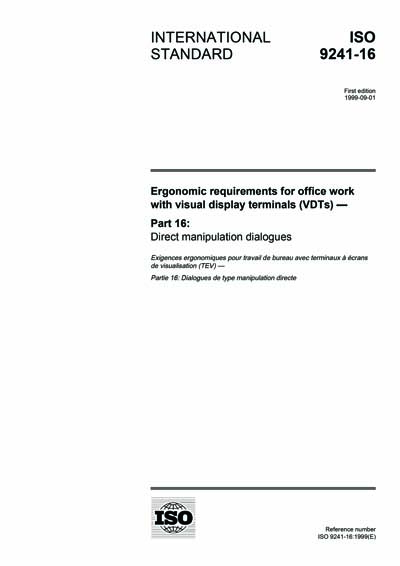Historical
ISO 9241-16:1999
Ergonomic requirements for office work with visual display terminals (VDTs) -- Part 16: Direct manipulation dialogues
This part of ISO 9241 provides guidance on the design of direct manipulation dialogues. In direct manipulation dialogues the user directly acts on objects on the screen; for example, by pointing at them, moving them and/or changing their physical characteristics (or values) via the use of an input device. Such objects are typically concrete, often graphical, representations of abstract software structures or capabilities and generally fall into two categories.
- Task object — a metaphorical representation of a real-world artefact manipulated to support the user's task (e.g. a sheet of paper, pen, spanner, graph).
- Interface object — an object introduced into the interface so that the user can perform tasks related to the use of the computer application or system. This introduced object may be a real-world object but the metaphor is not directly related to the user's real work task (e.g. button, slider, window, screen).
Objects and their representations on the display are referred to as objects, except where it is necessary to make a clear distinction.
Interfaces that use stereoscopic or virtual reality-type interfaces are not covered in this part of ISO 9241.
In practice, the term direct manipulation is often used interchangeably with graphical user interfaces (GUIs). However, within GUIs other dialogue techniques, such as menu dialogues or command dialogues, are often implemented as well. Though GUIs can provide many direct manipulation features, not every user input in GUIs can be interpreted as direct manipulation. For example, printing a document by moving a document icon upon a printer icon implies a higher degree of direct manipulation than a mouse click on a push button labelled "print".
This part of ISO 9241 covers usability issues of direct manipulation dialogues. Recommendations on GUI components are given only if they are related specifically to features of direct manipulation.
Features of direct manipulation dialogues such as step-by-step input may be inefficient (e.g., if one wishes to delete all files starting with "d"). Therefore, other interaction techniques; for example, command input or menus, may be more appropriate and are typically used to supplement direct manipulation.
Content Provider
International Organization for Standardization [iso]






